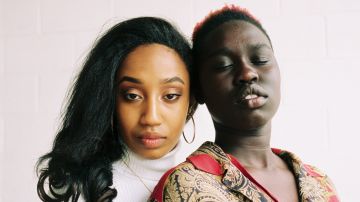How Colorism Erases Dark-Skinned Women
Last month, Jada Pinkett Smith posted a now-viral video featuring a young girl lamenting the experience of being a dark-skinned person of color

Photo: Unsplash/@gemmachuatran
Last month, Jada Pinkett Smith posted a now-viral video featuring a young girl lamenting the experience of being a dark-skinned person of color.
https://www.instagram.com/p/BqsA_lCDMnV/
The video came from Baltimore school teacher Valencia Clay’s homeroom class; in it, an eighth-grade girl describes how dark-skinned Black girls experience both racism and colorism. With vulnerability and strength, she uses the safe space created by Clay to talk about colorism and how it chooses who is worthy to be praised.
Through tears, she confessed that “everybody’s in love with them” speaking of lighter-skinned girls. In an instant, it seems, she verbalizes and then swallows her truth: it is her skin – richer, deeper, unmistakably blacker – that precludes her from the actualization of being seen and loved.
“I’m not,” she simply states, referring to her attractiveness, and perhaps, ability to exist in the space of many people’s hearts and mind.
To be a person of color with dark skin is complex and simple all at once. Dark-skinned people are often immediately identified and categorized very simply by those who are lighter, white, or simply undereducated about race and ethnicity.
At a glance, they are often considered racially and ethnically Black at best or undesirable and threatening at worst — either way, the complexities of their ethnicity, sexuality, desirability, and humanity, go without consideration.
As if worth more consideration and attention, lighter-skinned people of color often report being deeply scrutinized for their ethnicity, race, nationality, and proximity to whiteness. While they are plagued with complex questions of “what are you,” dark-skinned people find themselves never being asked. These simple assumptions create a very complex existence.
While neither treatment alleviates the racial anxiety all people of color feel, the former suggests that to be dark-skinned — appearing Black — means experiencing a lifelong emotionally wrought lesson in visibility and invisibility. While one cannot escape the skin that causes them to stand out even among their own race, they are also often fighting to be seen (or written off) as more than just dark-skinned.
This is the reality of colorism. It creates a society of sorts — one in which countless dark-skinned people of color have had memberships. From Afro-Latinos to African Americans to Caribbeans to Indians, people of color from every ethnicity who are of a darker hue have found themselves on the outskirts of a world dominated by white supremacy and marginalized in communities where their peers and blood relatives look less overtly “Black.” And when colorism and non-whiteness collide, they become a “super oppressor” that leaves many dark-skinned people to question their place in a world that continues to celebrate white proximity.
For many years, my own experience with my skin color has varied – providing an experience that many caramel brown people of color can remember all too well. Growing up surrounded by mostly Caucasian people, I have vivid memories of my immediate dismissal – particularly when it came to the male gaze – but also among those influenced by it. My first-grade best friend began to sing “nigger girl” when she saw me coming after her older brother confirmed that I was not just one of her new friends, but a Black girl, “a nigger,” he emphasized. I had encountered him only once, in passing, at her home. Yet, by high school, as I surrounded myself with more people of color, I became “light-skinned,” and took on an oddly new role as the center of some girls’ envy for being “not so dark” and the simultaneous center of effection for some boys. By college, the roles had changed again as I spent more time with Latinas and white women and African Americans and Caribbeans. Finally, it became clear that we all existed on a spectrum and my color could make me a target depending upon who was watching.
My memories – as the “nigger,” as the light-skinned girl, as the “too dark for Black guys, yet light enough for Dominicans” girl – eventually gave me an intimate connection to the oppressive nature of colorism. I was complicit and I was its target; a simple and complex relationship.
I understood what it meant to be quickly written off for my skin color and I also danced in the sunny feeling of being magnificently caramel girl. But most importantly, I knew how racism and colorism worked together to create the lens through which I began to view myself. Similar to the girl in Clay’s classroom, I was seeing myself through the many oppressive gazes that all women of color live under; because depending upon the rooms we stand in, we will find ourselves to be too much or not enough. We can be dark voids that no one will see or bright lights for everyone to take in with wonder. When it comes to our own self-exploration and growth, to overcome colorism internally, we must decide whether we’ll use the eyes of racism and colorism to see ourselves or whether we’ll search ourselves for truth.
But the young girl in the video, as she buried her face from view, captured the greater challenge — one that goes beyond our own self-image and forces us to take on society at large. She clarified, with only her tears, that colorism creates the condition in which praise, adoration, intimacy, and love exist in a caste – only available to those who, by the birthright of their skin, we choose to see. It’s up to us to choose to look at each other differently.















